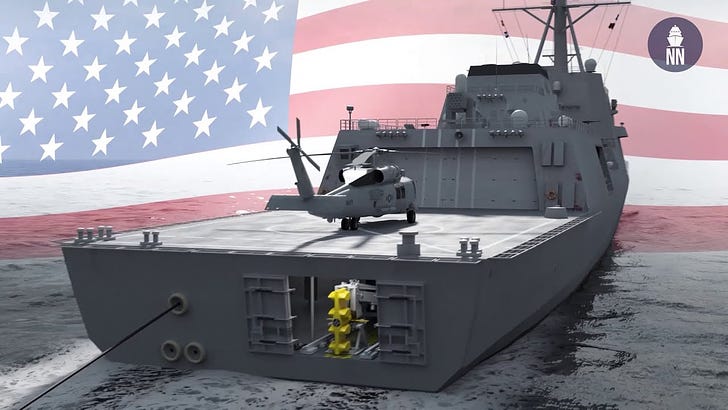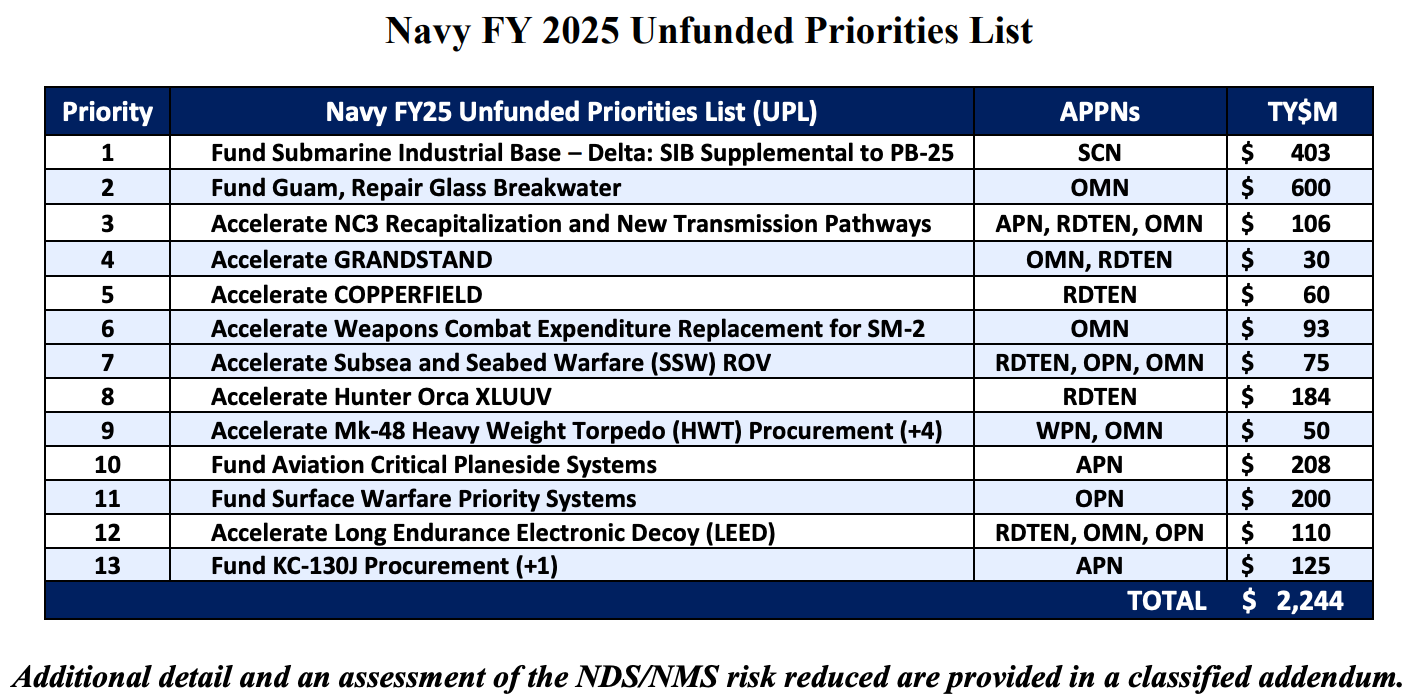If you remember from my post a couple of weeks ago when the President’s defense budget was presented, my first question was;
Over the last six months, how many SM-2/3/6 have we fired in the Red Sea? Is that more or less than 125?
I still don’t have a firm answer on that. This continues to nag at the back of my mind. I’m not saying I’m hearing footsteps, but I’m hearing a few footsteps.
So, looking over the Navy’s Unfunded Priorities List, (and you know how much I love Unfunded Priorities Lists), #6 popped out to me right away;
There we go. Here’s the little gritty detail; we are investing production in the more capable SM-6, but we have A LOT of SM-2 in inventory that do just a fine job for most target sets, but don’t let the inventory numbers, should you get an eye on them, fool you.
That does not mean those missiles are ready for the game.
The devil is in the details;
It begs the question; “What percentage of our inventory of SM-2 are “non-combat usable?”
Someone with access to classified information should ask that question.
This seems like low-hanging fruit; upgrading existing but otherwise useless missiles into something that can take care of most required business. These are high-demand/low-density weapons right now - and yet replacing the unexpected expenditure in the Red Sea remains on <checks notes> the Unfunded Priorities List?
Really?
Let’s shift fire a bit while we’re on the topic of Surface to Air Missiles. When doing a little research on the above, I came up with a few little details that I thought I’d share.
Did you know … we’re working on getting Patriot to sea? Not just Aegis Ashore or Cooperative Engagement Capability, it appears;
For the first time, Lockheed Martin’s Patriot Advanced Capability – 3 (PAC-3) Missile Segment Enhancement (MSE) interceptor successfully communicated with the AN/SPY-1 Radar, a key component in the Aegis Weapon System.
Lockheed Martin is investing in a PAC-3 MSE/Aegis integration that could deliver a proven, Integrated Air and Missile Defense capability with growing capacity to help maritime customers defend against advanced, maneuverable threats.
“This successful test is a major step forward to fully integrate PAC-3 MSE into the Aegis Weapon System,” said Tom Copeman, vice president, Naval Systems, Lockheed Martin Missiles and Fire Control. “A PAC-3 MSE/Aegis integration delivers a hardened defense to maritime fleets on an affordable, rapid timeline.”
Note the production number as opposed to the 125 Standard Missile buy expected next year.
PAC-3 MSE’s unmatched Hit-to-Kill capabilities defends against advanced threats including tactical ballistic missiles, cruise missiles and aircraft. Currently, the PAC-3 MSE program is ramping up to 550 MSEs a year, with plans to continue growing. In 2022, Lockheed Martin opened a new 85,000-square-foot building expansion at the Camden, Arkansas, facility to support increased production capacity for PAC-3 MSE.
SPY-1 radars exist on nearly 100 U.S. Navy Aegis Cruisers and Destroyers, and with proven performance and growing capacity, integrating PAC-3 MSE with Aegis can help sailors stay ahead of evolving threats.
I can hear ya’ll on the front porch from here, “Sal, can a Patriot even fit in a MK-41 VLS cell?”
Lockheed Martin showcased a Mark 41 Vertical Launch System (VLS) capable Patriot missile for the first time at the Surface Navy Association (SNA) 2023 National Symposium. The display consisted of a single Patriot Advanced Capability-3 Missile Segment Enhancement (PAC-3 MSE) launching from one Mk 41 VLS cell.
OK, that’s sexy.
Sexy is great - but it is the numbers that sell the concept;
But the SM-6 is complex. For a decade now, the Navy has been paying Raytheon to build 125 of the missiles per year at a cost of slightly more than $4 million per missile; the fleet has around 600 in stock. The production rate should increase slightly in the coming years.
Even taking into account the fleet’s large arsenal of less-capable SM-2s, there’s a real danger it could get overwhelmed by enemy missiles, drones and warplanes during, say, a war with China over Taiwan.
Consider how many missiles, drones and planes Russia has hurled at Ukraine in the 23 months since the former widened its brutal war on the latter. The Ukrainian general staff claims its forces have, so far, shot down nearly 1,100 drones, nearly 500 manned aircraft and around 250 cruise missiles.
While the tally of aircraft shoot-downs almost certainly is an overcount, it’s plausible the other tallies are accurate. Since many air-defense missiles miss, Ukrainian batteries have had to fire thousands to shoot down those roughly 2,000 targets.
All that is to say, in a major war the US Navy should expect to contend with thousands of aerial targets – and should expect to fire thousands more missiles just to defend itself.
There’s almost no prospect of Raytheon ramping up production of SM-6s to, by itself, meet the fleet’s missile needs in the worst-case scenario: a war with China. What the Navy needs, in Lockheed’s estimation, is a cheaper missile. And one that’s already in mass-production.
The $4-million Patriot PAC-3 fits the bill, according to the firm. The 17-foot, 700-pound PAC-3 ranges just 50 miles – less than half the range of the SM-6 – but it’s got a highly accurate radar seeker and 180 tiny pulse motors that make it extremely maneuverable.
Ukraine has used older Patriots called “PAC-2s” to shoot down Russia’s much-hyped Kinzhal hypersonic missiles – and also to stage complex ambushes of manned warplanes. When the Ukrainians shot down one of the Russian air force’s rare A-50 radar planes over the Sea of Azov last month, they apparently used salvos of PAC-2s.
The PAC-3 “brings the Navy a great capability,” Lockheed official Tom Cavanaugh told Naval News last year. And as a bonus, Lockheed is already building 550 PAC-3s a year – and expects to increase that production rate over the next few years as the war in Ukraine fuels demand.
The PAC-3 might not be any cheaper than the SM-6, but it is available in larger numbers than the bigger missile.
Build more faster, please.






Another thought. Companies are expanding factories in fixed locations, not building new ones. What are we doing to provide for the defense of those fixed targets? You figure we have 2 sub builders, 1 CVN builder, and half a dozen(?) missile facilities. What if some of those 25,000 military aged male Chinese who entered illegally last year had nefarious intent? What if they were just going to lase for a SLCM? What is the plan for defending our defense plants? (Hint, none). So, in one fell swoop, we could have zero industrial base to resupply our Navy at sea.
Gee, they would NEVER do that, would they?
a couple of comments:
1. "For a decade now, the Navy has been paying Raytheon to build 125 of the missiles per year at a cost of slightly more than $4 million per missile; the fleet has around 600 in stock. The production rate should increase slightly in the coming years."
The math would seem like we expended half our annual production over 10 years?
2. the PAC3 has a shorter range, but seemingly 1 big edge for the Navy. Learn to shoot them and Army stocks become a deep reserve.